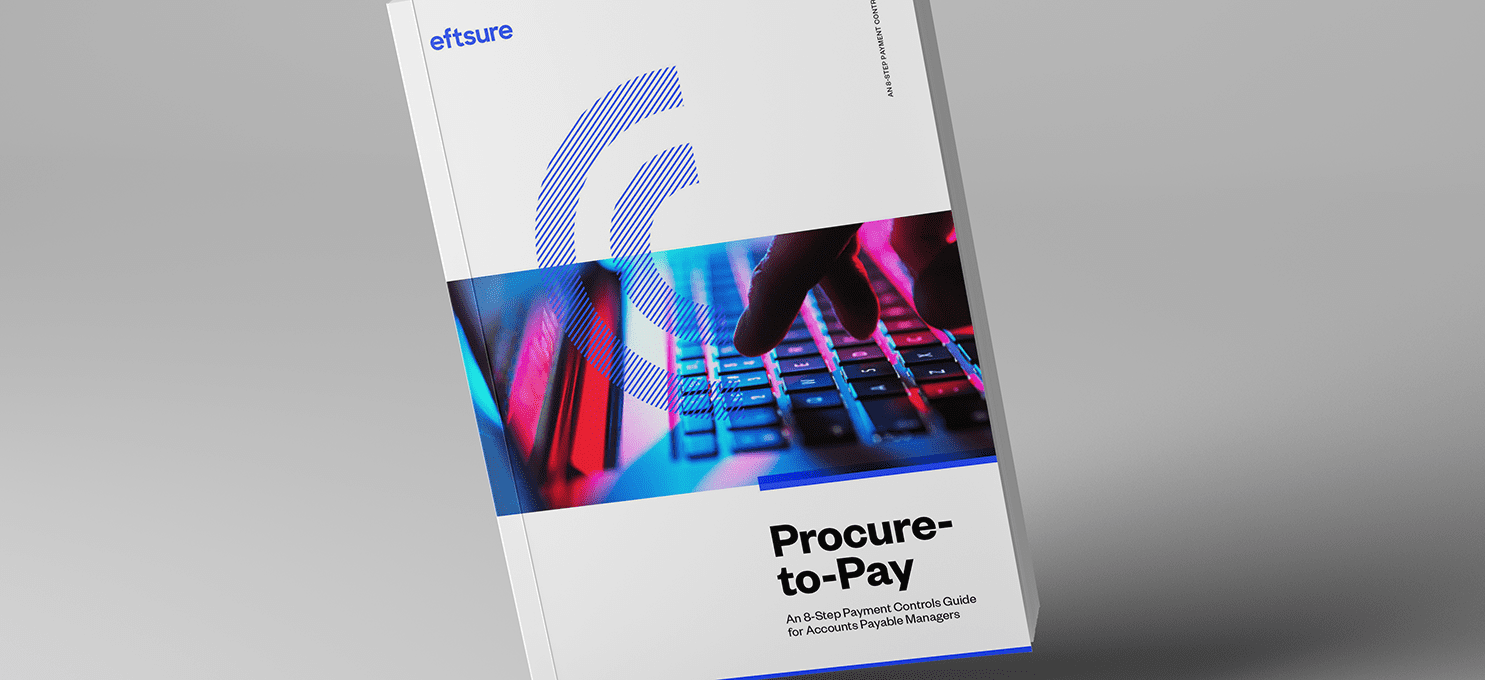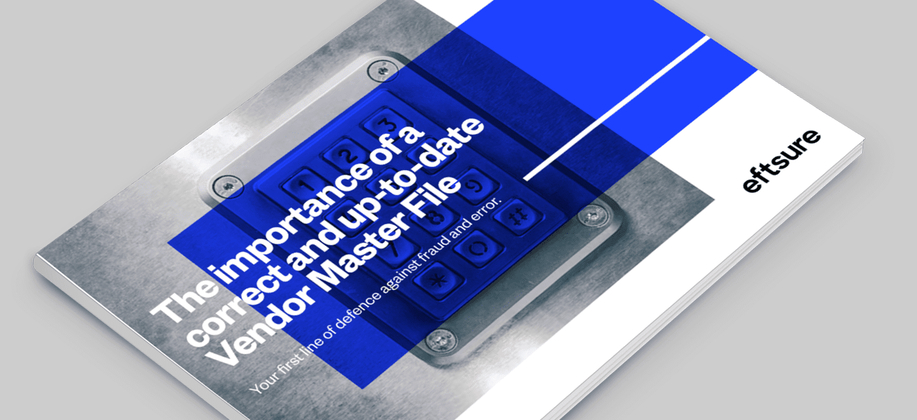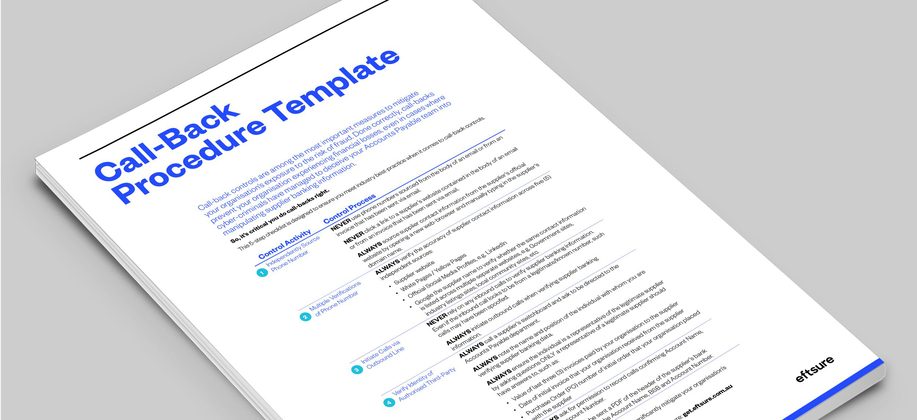The goal of the accounts payable (AP) function in any organisation is simple: to only pay invoices that are legitimate and accurate.
At first glance, this goal seems straightforward. However, any AP function can quickly become overwhelmed when processing large numbers of invoices from hundreds, if not thousands, of suppliers. Without rigorous financial controls in place, your organisation may face significant losses due to fraud and error throughout the procure-to-pay cycle.
Eftsure allows you to process EFT payments to suppliers without the risk of irretrievably sending funds to the incorrect payee due to fraud or human error.
The procure-to-pay cycle involves many steps. Ensuring your AP team always adheres to all your payment controls can be challenging. However, with Eftsure integrated into your accounting systems, you can rest assured that the correct payments are being sent to the correct recipients.
The following 8-step procure-to-pay checklist ensures your AP function follows best-practice principles to mitigate the risk of incorrect payments. At the end of the guide, print and retain our handy checklist to ensure you're ticking all the right boxes every time an invoice needs paying.
Requisition request
The first step to ensuring your accounts payable function runs effectively and efficiently is having clear requisition policies and procedures set by your organisation’s board or senior management.
These rules must clearly stipulate the types of requisition requests, including dollar values, that require managerial authorisation. When necessary, the rules must specify which specific managers in each function or department are tasked with approving or denying requisition requests. Budgetary parameters must also be clearly stipulated in advance.
Quality assurance controls may also need to be mandated for certain types of goods or services. For example, prior to purchasing third-party software, a department manager may need approval from an IT manager to ensure the software meets minimum security standards.
All staff must be aware of the requisition policies and procedures, which typically include:
Requisition request form
An employee (requisitioner) requests the purchase of goods or services by completing a requisition request form. Depending on the type and value of the purchase, the requisitioner may need to obtain quotes and product specifications from multiple prospective suppliers. Contractual negotiations may also be required.
Requisition request screening
The requisition request form is submitted to a purchasing agent who screens it to ensure all necessary information is included. If information is missing, it may be returned to the requisitioner pending additional details.
Requisition request authorisation
The requisition request form is escalated to the relevant manager for authorisation. If approved, it is forwarded to the finance team to issue a purchase order.
Purchase order
Once an internal agreement is reached, the supplier is notified via a purchase order (PO).
The process for issuing a PO includes:
Purchase order creation
A purchase order should be drafted by the finance team once a requisition request is authorised. Best practice requires checking if the supplier exists in the vendor master file. The PO should include a unique purchase order number.
Purchase order approval
Before sending a purchase order to a supplier, a final approval is required to include any amendments.
Purchase order dispatch
Once approved, the purchase order is sent to the supplier, with copies provided to:
- The requisitioner
- The receiving department
- The AP team for filing under the supplier's account
Vendor master file
Maintaining an accurate and up-to-date vendor master file is critical. Data anomalies increase the risk of payment errors and internal fraud.
Steps to onboard new suppliers:
Compliance checking
Independently verify supplier details such as registered name, ABN, and GST status at onboarding and prior to payment release.
Credit worthiness
Obtain credit reports to assess suppliers' ability to deliver goods and services.
Naming conventions
Use consistent naming conventions to avoid duplicate payments.
Data hygiene
Segregate duties for data input and validation to maintain clean, accurate records.
Call backs
Call-back controls are essential for verifying supplier information and preventing fraud.
Receiving and inspection reports
Organisations must ensure that suppliers fulfil their obligations before processing payments. Best practices include:
Centralised receiving
Deliver goods to a receiving department for accurate record-keeping.
Receiver inspection
Inspect deliveries immediately to verify quantities and conditions.
Requisitioner inspection
Conduct a thorough inspection against purchase order requirements.
Receiving report
Ensure completed reports are available to AP teams for validation.
Invoice handling
Efficient systems and procedures are critical to validate invoices properly.
Electronic invoices
Encourage suppliers to use electronic invoices and send them to a dedicated AP email address.
Invoice encoding
Dedicated individuals should encode invoice data into ERP systems, with segregation of duties enforced.
Incomplete or incorrect invoices
Work with suppliers to amend errors before processing payments.
Invoice challenges
Unidentified invoices
Return unidentified invoices to suppliers for clarification.
Missing invoice numbers
Suppliers must issue unique invoice numbers.
Discrepant invoices
Resolve discrepancies by liaising with suppliers and requisitioners.
Short-paying invoices
Document reasons for short payments to maintain accurate audit trails.
Invoice matching
AP teams must use 2, 3, or 4 way matching systems depending on the invoice size and complexity.
| | 2 way | 3 way | 4 way |
|---|
| Invoice | Check | Check | Check |
| Purchase order | Check | Check | Check |
| Receiving report | | Check | Check |
| Inspection report | | | Check |
Continuous controls monitoring (CCM)
Continuous controls monitoring ensures payment data remains accurate up to the point of processing.
Spot checks
Random payment items should be manually verified but are less effective than full CCM solutions.
CCM technology
Automated CCM validates payments and payee details in real-time, reducing the risk of fraud and human error.
Final authorisation
Payments must undergo a final executive-level validation following CCM best practices.
Conclusion
Following these eight steps ensures your accounts payable function operates effectively while minimising fraud and error risks throughout the procure-to-pay cycle.
By adopting a shift left approach and leveraging platforms like Eftsure, organisations can drive efficiencies and enhance controls across the AP function.
Print and retain the checklist that follows to ensure your AP team consistently follows best practices.






